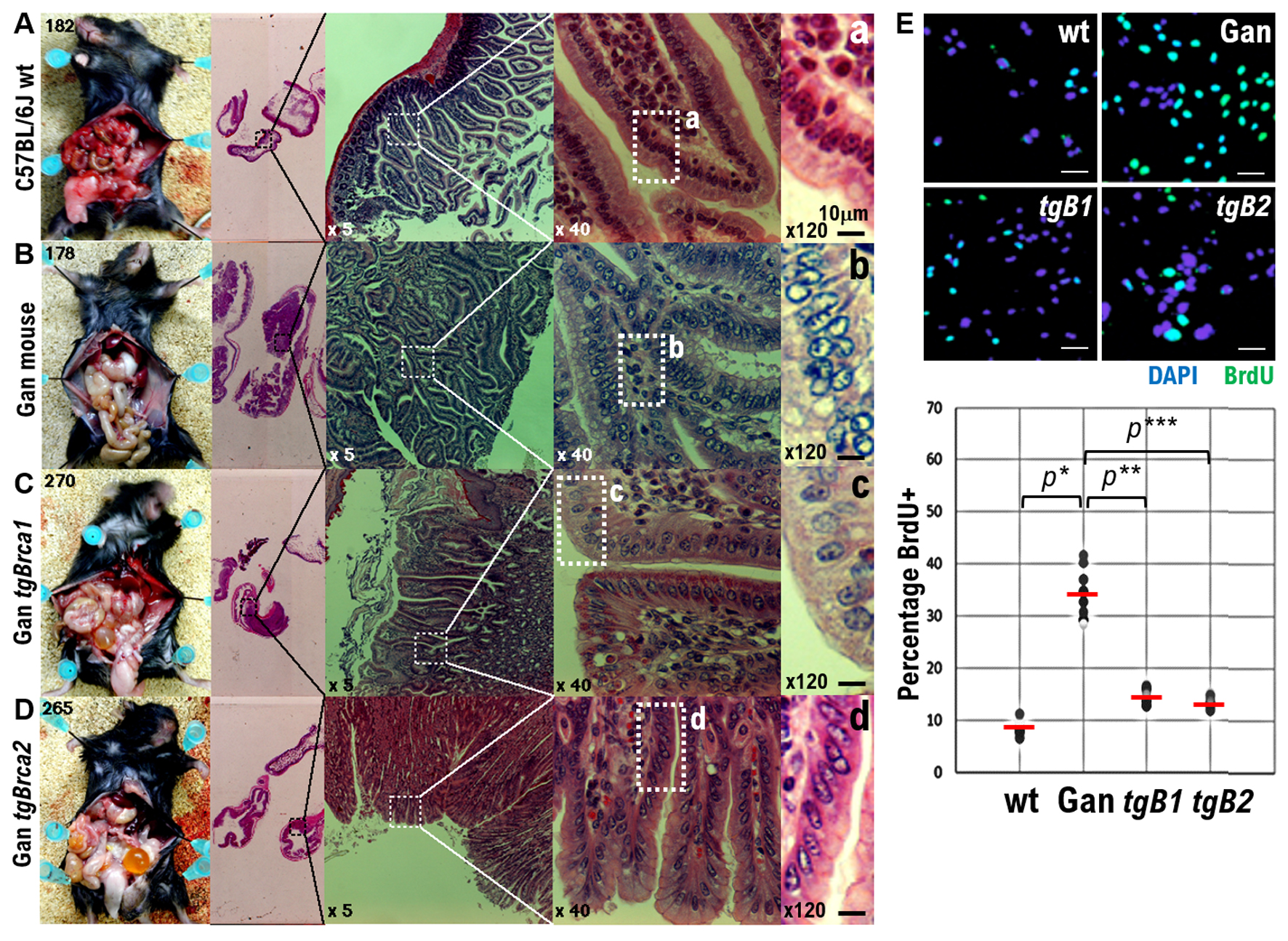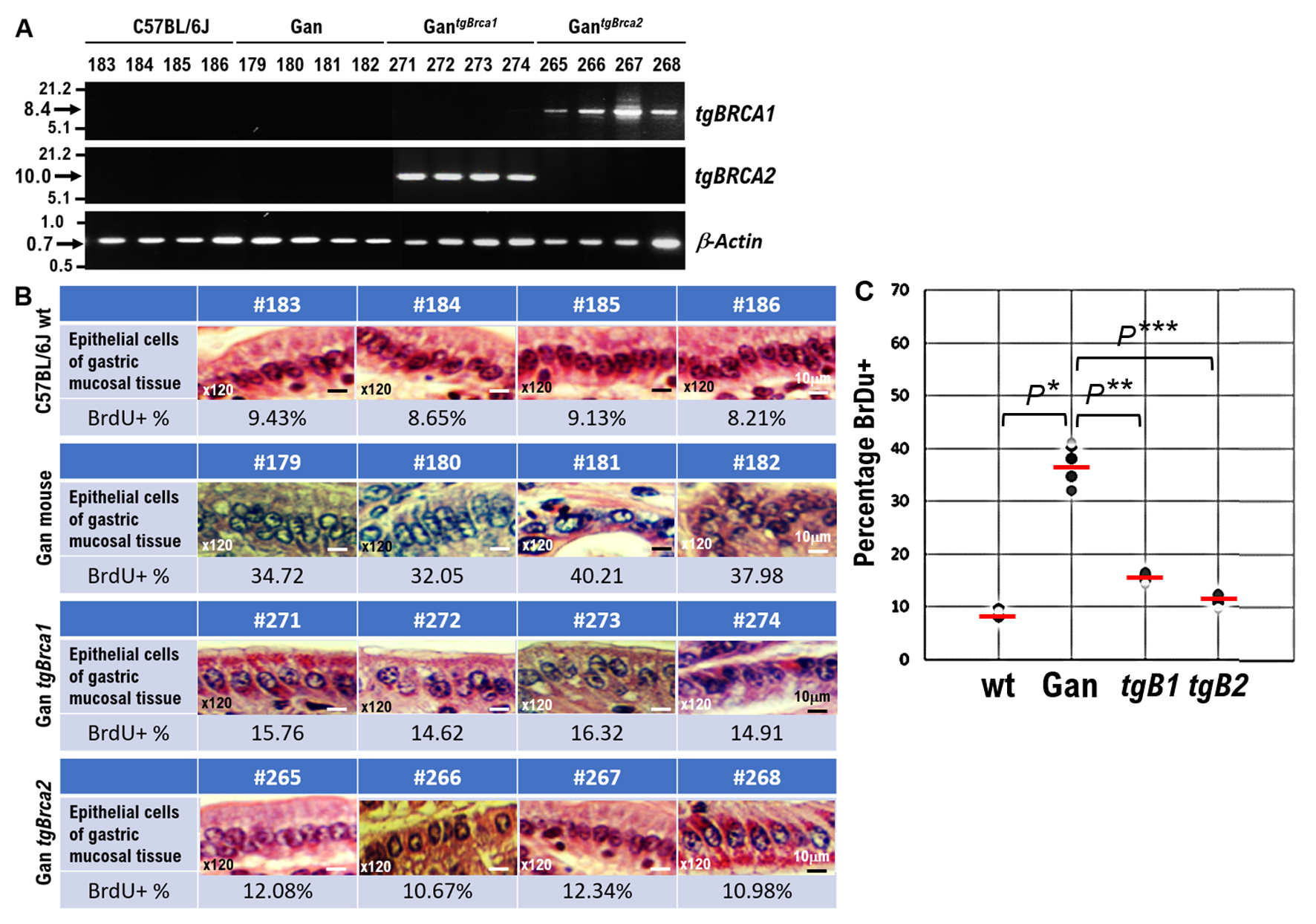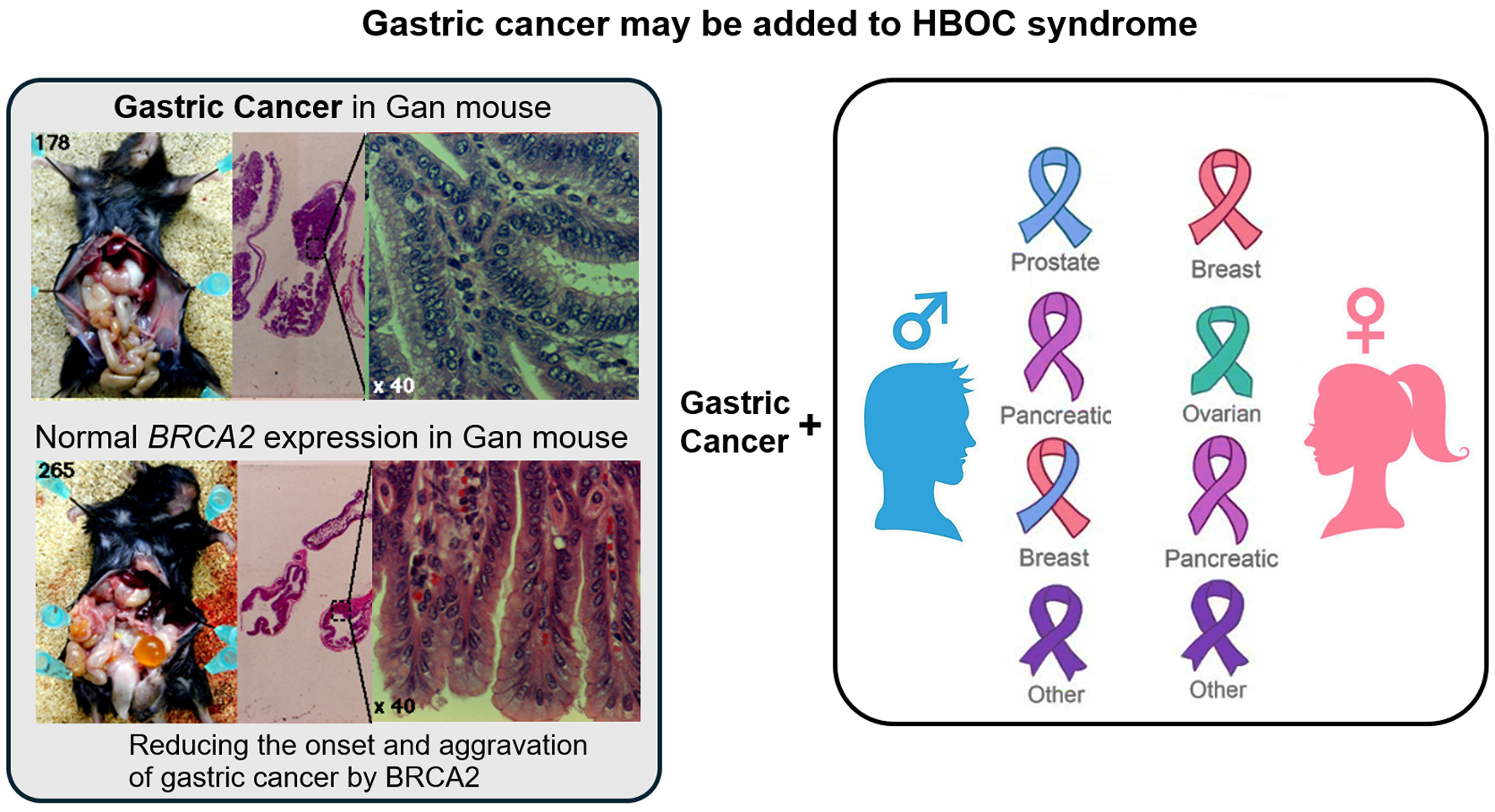
Figure 1. Effects of wild-type BRCA1 and BRCA2 expression on gastric cancer (GC) development in Gan mice, a mouse model of GC. (A) Photographs showing surgical pathological findings of normal epithelial cells in gastric mucosal tissue of wild-type C57BL6J mice. (B) Photographs showing surgical pathological findings of highly atypical epithelial cells in gastric mucosal tissue developed in Gan mice. (C) Photographs showing surgical pathological findings of mildly atypical epithelial cells in the gastric mucosal tissue developed in GantgBrca1 mice constitutively expressing BRCA1. Decreased number of atypical epithelial cells in gastric mucosal tissue. (D) Photographs showing surgical pathological findings of epithelial cells in the gastric mucosal tissue in GantgBrca2 mice constitutively expressing BRCA2. Significantly less atypical epithelial cells can be observed in gastric mucosal tissue. The gastric mucosal tissue of GantgBrca2 mice pathologically resembles normal tissue. (a-d) Enlarged images of tissue areas showing pathological findings of epithelial cells in the gastric mucosal tissue of each mouse at × 40 magnification. In other words, these images have been further enlarged to × 120. Scalebars, 10 µm. (E) Each genetically modified mouse was inoculated with a BrdU solution, and proliferation of epithelial cells in the gastric mucosal tissue of each genetically modified mouse was examined by the number of BrdU-positive cells. The number of BrdU-positive cells in the epithelial cells of the gastric mucosal tissue of wild-type C57BL6J mice is extremely small. The number of BrdU-positive cells in the epithelial cells of the gastric mucosal tissue of the Gan mice was extremely large. The number of BrdU-positive cells in the epithelial cells of the gastric mucosal tissue of GantgBrca1 mice was reduced. The number of BrdU-positive cells in the epithelial cells of the gastric mucosal tissue of GantgBrca2 mice was significantly reduced. The percentage of number of BrdU-positive cells observed among epithelial cells of the gastric mucosal tissue of each genetically modified mouse is plotted in the graph. *P < 0.001, **P < 0.005, ***P < 0.002.

Figure 2. Effects of wild-type BRCA1 and BRCA2 expression on gastric cancer (GC) development in Gan mice, a mouse model of GC. (A) The results of reverse transcriptase polymerase chain reaction (RT-PCR) showing Brca 1 wild type or Brca2 wild type mRNA expression in GantgBrca1 or GantgBrca2 mice. (B) Surgical pathological findings of normal epithelial cells in gastric mucosal tissue of wild type C57BL6J mice (mouse ID number #183, #184, #185, #186). Surgical pathological findings of highly atypical epithelial cells in gastric mucosal tissue in Gan mice (mouse ID number #179, #180, #181, #182) and mildly atypical epithelial cells in the gastric mucosal tissue of GantgBrca1 mice (mouse ID number #271, #272, #273, #273) constitutively expressing BRCA1. The atypical epithelial cells in gastric mucosal tissue are reduced in this mouse. The surgical pathological findings of atypical epithelial cells in the gastric mucosal tissue of GantgBrca2 mice (mouse ID number #265, #266, #267, #268) constitutively expressing BRCA2 were significantly reduced. Pathologically, the gastric mucosal tissue of GantgBrca2 mice (mouse ID number #265, #266, #267, #268) resembles normal tissue. These images of the gastric mucosal tissue have been enlarged to × 120. Scalebar, 10 µm. (C) Each genetically modified mouse was inoculated with a BrdU solution, and the proliferation of epithelial cells in the gastric mucosal tissue of each genetically modified mouse was examined using the number of BrdU-positive cells as an indicator. The number of BrdU-positive cells in the epithelial cells of the gastric mucosal tissue of wild-type C57BL6J mice is extremely small. The number of BrdU-positive cells in the epithelial cells of the gastric mucosal tissue of the Gan mice was extremely large. The number of BrdU-positive cells in the epithelial cells of the gastric mucosal tissue of GantgBrca1 mice was reduced. The number of BrdU-positive cells in the epithelial cells of the gastric mucosal tissue of GantgBrca2 mice was significantly reduced The percentage of number of BrdU-positive cells observed among epithelial cells of the gastric mucosal tissue of each genetically modified mouse is plotted in the graph. *P < 0.001, **P < 0.005, ***P < 0.001.

Figure 3. The gastric cancer observed in some patients may be part of the hereditary breast and ovarian cancer (HBOC) syndrome. BRCA1/BRCA2 protect DNA replication forks by repairing damage (DNA double-strand breaks (DSBs)) during nuclear genomic DNA replication. In particular, in maintaining the stability of cellular genome (genome stability). BRCA1/2 genes are typical tumor suppressor genes, and loss-of-function mutations in BRCA1/2 significantly increase the risk of developing breast and ovarian cancers, as well as some prostate and pancreatic cancers. The present results indicate that BRCA1 or BRCA2 pathogenic variants may be involved in the malignant transformation of epithelial cells in the gastric mucosal tissue. Therefore, the gastric cancer observed in some patients could be part of the HBOC syndrome.


